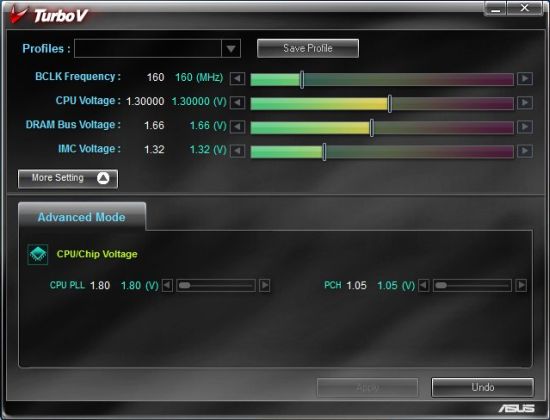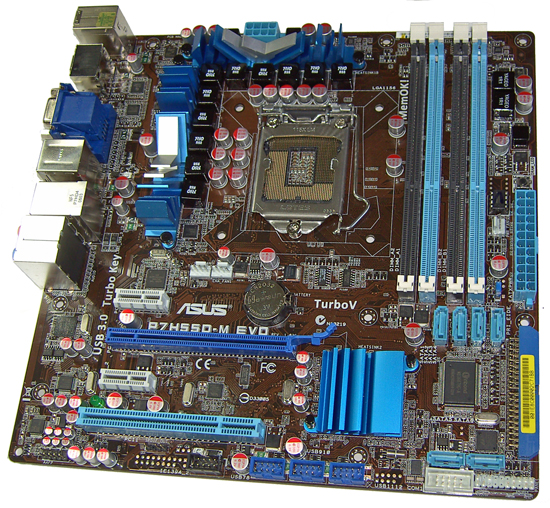Choosing the Best H55/H57 Motherboard - Part 1
by Rajinder Gill on January 31, 2010 11:30 PM EST- Posted in
- Motherboards
ASUS P7H55D-M EVO
The ASUS P7H55D-M EVO is currently priced at $135 at Newegg.
| ASUS H55D-M EVO | |
| Market Segment | H55 General Use/HTPC |
| CPU Interface | LGA-1156 |
| CPU Support | LGA-1156 i3/i5/i7 Series of Processors |
| Chipset | Intel H55 Express Chipset |
| BCLK Speeds | 80-500MHz in 1MHz increments |
| DDR3 Memory Speed | 800, 1067, 1333 Frequency Ratios |
| QPI Frequency | All supported mutlpier ratios available |
| Core Voltage | 0.85V ~ 1.70V in 0.00625V increments |
| CPU Vdroop Compensation | On/Off |
| CPU Clock Multiplier | Dependant on Processor, all available multipliers supported |
| DRAM Voltage DDR3 | Auto, 1.20V ~ 2.20V in 0.02V increments (1.50V base) |
| DRAM Timing Control | tCL, tRCD, tRP, tRAS, + 15 Additional Timings |
| DRAM Command Rate | Auto, 1N, 2N and 3N |
| PCH Voltage | Auto, 1.05V ~ 2V in .01V increments, 1.05V Base |
| CPU VTT (Uncore) Voltage | 1.1V ~ 1.90V in 0.02V increments |
| CPU PLL Voltage | 1.8V ~ 2.2V in 0.02V increments, 1.80V Base |
| Memory Slots | Four 240-pin DDR3 DIMM Slots Dual-Channel Configuration Regular Unbuffered DDR3 Memory to 8GB Total |
| Expansion Slots | 1X PCIe 2.0 16X Slot 2x PCIe X1 slots 1 X PCI slot |
| Onboard SATA/RAID | 6x SATA 3.0Gbps Ports - Intel Chipset Marvell 88SE6111 SATA and PATA Controller 1X Ultra DMA 133/100/66 for up to 2 PATA devices 1 X External SATA 3.0 Gb/s port |
| Onboard USB 2.0 | 10 USB 2.0 ports (4) I/O Panel, 6 via brackets 2 X USB 3.0 connectors on rear I/O (NEC USB 3.0 controller) |
| Onboard LAN | Realtek 8112L Gigabit LAN (PCI/e) |
| Onboard Audio | Realtek ALC889 High Definition Audio Codec, 7.1 Channel. |
| Other Onboard Connectors | 1X FPA, 1X 1394, 1X COM, 1X S/PDIF |
| Power Connectors | ATX 24-pin, 8-pin EPS 12V |
| I/O Panel | 1 x PS/2 Keyboard 1 x RJ45 4 x USB 2.0/1.1 1 x eSATA 2 x USB 3.0 1 x Optical Toslink 1 x HDMI 1 x RGB 6 Audio I/O jacks |
| Fan Headers | 1 CPU + 2 Additional Headers |
| Fan Control | Full temp/speed fan control for CPU header via BIOS or OS software Additional headers have 3 step speed control via BIOS or OS software |
| Package Contents | 2X SATA cables, 1 X UDMA cable, User Guide, 1 X Q-Connector, 1 X Driver/software DVD, 1 X I/O Shield. |
| Board/BIOS Revisions Used | Board Rev: 1.03G BIOS Files Used: 0503 and 0701 |
| Form Factor | uATX (9.6 in. X 9.6 in.) |
| Warranty | 3 Year Standard |
The P7H55D-M EVO package contents include: two SATA cables, one UDMA cable, User Guide, one Q-Connector, Driver/software DVD, and I/O Shield. That's a little light on SATA cables for our liking; a couple of extra would have been nice, as would the inclusion of a USB bracket to make use of the internal headers.
On the hardware front you get standard Realtek ALC889 audio, Realtek 8112L PCI-E LAN, two 1394 ports (VIA VT6308P), and two USB 3.0 ports thanks to the inclusion of NEC's controller chip. Unlike MSI and ASRock you don't get a TPM header; we're not sure what the uptake for this technology is right now, but it's something to bear in mind if you have plans to make use of it in the future.
Software
ASUS's driver DVD comes bundled with a slew of tools: PC Probe for software/temp monitoring, AI Suite/Fan Expert for setting up fan profiles, Express Gate for a quick-boot Linux environment, and Turbo-V for overclocking.

Turbo-V is a simple OS-based tool that allows on-the-fly changes to bus speeds and voltages, as well as offering the option to save profiles. A GPU level driver is also included, which allows for overclocking the IGP within the OS. We found the supplied version of Turbo-V to be fully functional with our 661 Clarkdale in testing. Out of the three vendors on test here today, ASUS seems to have come the closest to getting things working right first time.
The Board

Slot layout on the P7H55D-M EVO is good, although there's only one full length PCI-E x16 slot limiting upgrade options for add-in RAID cards if you go with a discrete GPU. Instead, ASUS offers two PCI-E x1 slots, with one placed to be accessible regardless of slot loading. The IDE port could have been left out, although you still get six accessible SATA ports at the lower right corner for the board in spite of its presence.
Three onboard fan headers are on offer. Fan control is not very comprehensive for the power and chassis fan headers; you get a three-step control, which can be applied to ramp dynamically via software profiles. You don't get any onboard power buttons either, barring Mem-OK, which acts as a solution to most non-boot situations related to overclocking.
Onboard cooling is more than adequate to take care of most overclocking. If you do overclock your Clarkdale CPU over 4GHz, some air cross-flow over the PWM heatsinks will keep them cool enough under normal usage. Heatsink height is low, so the board caters for a variety of CPU cooler installations without orientation issues - unless you install memory modules with very tall heat spreaders in the primary DIMM slots, which can make things a little tight for fan placement.
Overclocking

4GB memory overclocking is not class leading; use the 2:10 memory ratio and you'll find you're limited to around 175 BCLK (DDR3-1750). The alternative is to stick with 2:8 (DDR3-1600MHZ) at around 200 BCLK with a CAS of 6 or 7, modules permitting. The bonus to this configuration is you get to keep a reasonable QPI multiplier ratio, thus delivering reasonable performance.
Moving up to 8GB, you're looking at being capped at DDR3-1550~1580 unless you relax the QPI multiplier ratio, which does not really make sense from a performance standpoint. Real world differences are of course small either way, but we aim to take whatever we can get from the chipset.
BIOS
BIOS 0701 is the comprehensive functionality and overclocking release from ASUS. You get the full array of DRAM timing options included from tRD register manipulation to fine control of voltage rails. DRAM timing adjustments are easy to make because the BIOS shows you every setting value when you select AUTO mode for the timings, giving you a base to work from. You can change one setting at a time while leaving all others on AUTO and it's simple to change something back if things go wrong. MSI would do well to learn something from this approach.
Voltage adjustments can be made easily too; you can type the voltage value in directly and the board will select the nearest offset. The ranges are quite granular so there's plenty of room for fine-tuning.
There are eight BIOS save locations available for profiles, which come in handy during initial setup or overclocking adventures. A built-in BIOS flashing routine is also provided, allowing easy updates from a USB pen drive or from a HDD.





















56 Comments
View All Comments
randercol - Friday, March 26, 2010 - link
stop smoking and drinking guys and girls.its not wrote in any bible that our next generation will in future will take smoking and drinking.its our bad manners and we grow it very fast when we were small then we were alive without that things so why should now?http://www.goarticles.com/cgi-bin/showa.cgi?C=2236...">http://www.goarticles.com/cgi-bin/showa.cgi?C=2236...
alimaamoser - Tuesday, March 16, 2010 - link
i think 55 is best anand....http://www.articlesbase.com/health-articles/dentas...">http://www.articlesbase.com/health-arti...-does-de...
jed22281 - Friday, March 19, 2010 - link
looks like this users acct needs to be deleted for spammingrandercol - Monday, March 22, 2010 - link
i think 53 is best for you and it is the best for you .http://www.articlesbase.com/wellness-articles/ther...">http://www.articlesbase.com/wellness-ar...eanse-re...
alimaamoser - Tuesday, March 16, 2010 - link
i think 55 is best.......http://www.articlesbase.com/health-articles/dentas...">http://www.articlesbase.com/health-arti...-does-de...
dentasmile md
Nomale - Thursday, February 18, 2010 - link
Is there any difference with h57 and p55 regarding xeon support? I don't think it's supported officially since it's aimed at the server market, but since it's based on lynnfield there seem to be no problem with p55 at least.Mrkock - Wednesday, February 10, 2010 - link
The first time I read this article, I got the impression that the H55/H57 boards don't support a Pci16x Video card.The second time I read this article, I was pretty sure about it.
So is that true, that the H55/H57 can't support additional Video cards (like a Nvidia or ATI graphics card)?
Rajinder Gill - Thursday, February 11, 2010 - link
Hi,H55/H57 will support a single GPU only for Clarkdale processors (so any 8x or 16x PCI/e GPU is fine).
If you want to run dual GPU configurations you have to use a Lynnfield series CPU.
regards
Raja
jtsh0ck3r - Friday, February 5, 2010 - link
Raja,For someone looking to upgrade an old system with an older PS with just the 4-pin 12V ATX connector, should they upgrade the PS as well?
Rajinder Gill - Friday, February 5, 2010 - link
Hi,You should be fine on 4 pin with Clarkdale, unless you plan on very heavy overclocking. Load power draw is under 100 watts in most scenarios when you run these CPU's at stock (around 8~10 amps from the 12V connector).
Hope the helps
Raja